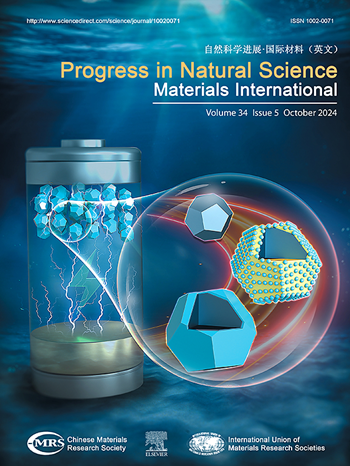富镍正极材料上残余锂化合物的形成机理及去除策略
IF 7.1
2区 材料科学
Q2 MATERIALS SCIENCE, MULTIDISCIPLINARY
Progress in Natural Science: Materials International
Pub Date : 2024-12-01
DOI:10.1016/j.pnsc.2024.08.010
引用次数: 0
摘要
锂离子电池采用富含镍的层状氧化物作为阴极,因为它们具有高比容量并且相对便宜。尽管如此,由于材料对空气的高度敏感性,其空气储存稳定性较差,并且锂化合物很容易在其表面积聚。因此,表面残余锂化合物富镍正极材料将降低其综合性能,使后续电极制造工艺复杂化,严重限制其实际应用。因此,研究残余锂化合物的表面去除具有重要的现实意义。本文总结了富镍正极材料表面残余锂化合物的来源,评价了这些化合物对材料的不利影响,并分析了减少或消除这些化合物的可行方案。最后,讨论了去除残余锂化合物的未来研究方向。本文章由计算机程序翻译,如有差异,请以英文原文为准。
Formation mechanism and removal strategy of residual lithium compounds on nickel-rich cathode materials
Lithium-ion batteries employ Ni-rich layered oxides as cathodes because they have a high specific capacity and are relatively inexpensive. Despite this, materials have poor air storage stability because of their high sensitivity to air, and it is easy for lithium compounds to accumulate on their surfaces. As a result, surface residual lithium compounds Ni-rich cathode materials will reduce their comprehensive properties, complicate the subsequent electrode manufacturing process, and severely limit their practical application. Hence, the study of surface removal of residual lithium compounds has great practical significance. A summary of the sources of surface residual lithium compounds of Ni-rich cathode materials is presented hereof, along with an evaluation of the adverse effects those compounds have on materials, and an analysis of feasible solutions to reduce or eliminate these compounds. Finally, a future research direction is discussed for eliminating residual lithium compounds.
求助全文
通过发布文献求助,成功后即可免费获取论文全文。
去求助
来源期刊
CiteScore
8.60
自引率
2.10%
发文量
2812
审稿时长
49 days
期刊介绍:
Progress in Natural Science: Materials International provides scientists and engineers throughout the world with a central vehicle for the exchange and dissemination of basic theoretical studies and applied research of advanced materials. The emphasis is placed on original research, both analytical and experimental, which is of permanent interest to engineers and scientists, covering all aspects of new materials and technologies, such as, energy and environmental materials; advanced structural materials; advanced transportation materials, functional and electronic materials; nano-scale and amorphous materials; health and biological materials; materials modeling and simulation; materials characterization; and so on. The latest research achievements and innovative papers in basic theoretical studies and applied research of material science will be carefully selected and promptly reported. Thus, the aim of this Journal is to serve the global materials science and technology community with the latest research findings.
As a service to readers, an international bibliography of recent publications in advanced materials is published bimonthly.

 求助内容:
求助内容: 应助结果提醒方式:
应助结果提醒方式:


